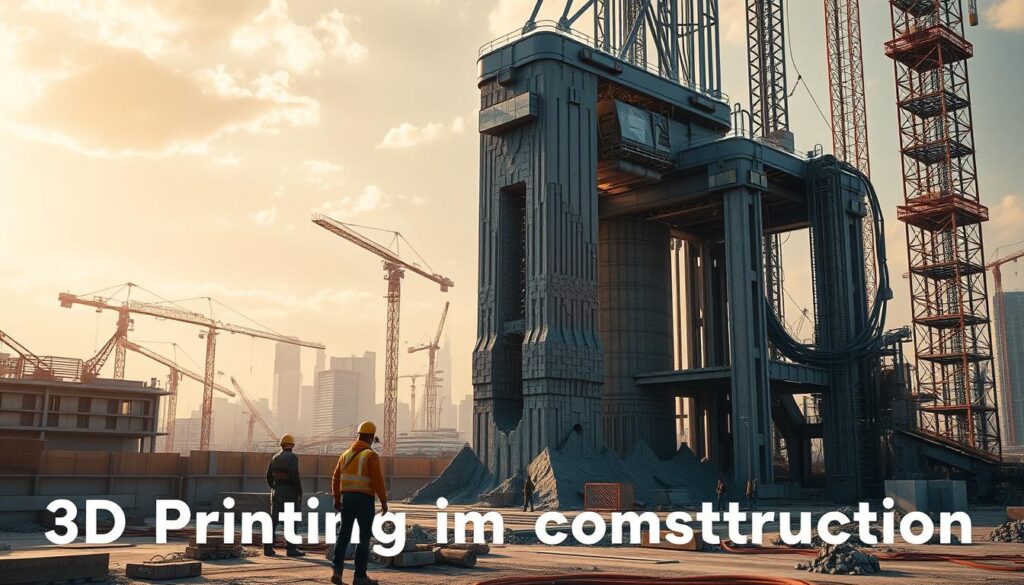The construction industry is on the cusp of a revolution, withadditive manufacturingtransforming the way buildings and structures are created. A staggering fact illustrates the potential scale of this change: if3D printing technologywere used on just 0.01 percent of construction sites, the market size would be massive.
The advent of 3D printing in construction is making it cheaper and faster to construct buildings, thereby revolutionizing the industry. Companies like COBOD have already made significant strides, using their machines to print buildings up to 4,100 ft2.
This technology addresses a significant portion of the total construction cost, up to 45 percent for residential housing and up to 80 percent for commercial applications. The future of construction is being reshaped by this innovative technology.
Key Takeaways
- The construction industry is being transformed by 3D printing technology.
- 3D printing can significantly reduce construction costs and time.
- Companies are already achieving impressive results with large-scale prints.
- The technology has the potential to revolutionize both residential and commercial construction.
- Future advancements are expected to further increase the capabilities of 3D printing in construction.
Introduction to 3D Printing in Construction
Construction is witnessing a paradigm shift with the introduction of 3D printing. This innovative technology is revolutionizing the way buildings and structures are designed and constructed. 3D printing technology for construction involves the automated process of manufacturing construction elements or entire structures by means of a 3D printer.
The applications of 3D printing in construction are vast and varied, ranging from creating complex architectural designs to building affordable housing. This technology allows for the rapid creation of structures with intricate details that would be difficult or impossible to achieve with traditional construction methods.
One of the key benefits of 3D printed construction materials is their potential for sustainability. Many 3D printing processes use recycled materials, reducing waste and the environmental impact of construction projects.
| Aspect | Traditional Construction | 3D Printing in Construction |
|---|---|---|
| Speed | Slow, labor-intensive | Rapid, automated |
| Complexity | Limited by traditional techniques | Capable of complex designs |
| Sustainability | Often wasteful | Utilizes recycled materials |
As the construction industry continues to adopt 3D printing technology, we can expect to see significant advancements in efficiency, sustainability, and innovation. The future of construction is being shaped by the capabilities and advantages offered by 3D printing.
History of 3D Printing in Construction
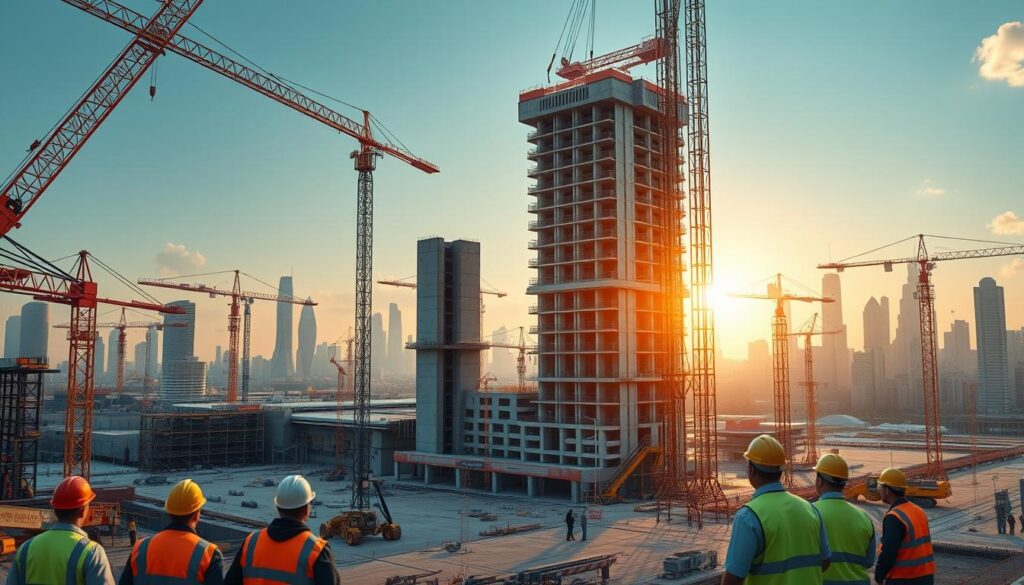
3D printing in construction has evolved significantly since its inception, marking a new era in building technology. The use of 3D printing in construction has been growing rapidly over the last five years, with significant advancements in technology and materials.
Early Innovations and Milestones
The journey of 3D printing in construction began with early innovations that paved the way for modern technology. One of the first significant milestones was achieved in the early 2010s when companies started experimenting with large-scale 3D printing for construction purposes.
Key milestones include:
- The development of the first 3D printed house in 2014 by WinSun, a Chinese construction company.
- The introduction of Contour Crafting technology, which was one of the first 3D printing technologies designed for large-scale construction.
- The successful printing of entire buildings and infrastructure using 3D printing technology.
These early innovations demonstrated the potential of 3D printing in construction, showcasing its ability to reduce construction time, lower costs, and increase sustainability.
Key Players in the Market
Several companies have been at the forefront of 3D printing in construction, driving innovation and adoption. Some of the key players include:
| Company | Notable Achievements | Country |
|---|---|---|
| WinSun | First 3D printed house in 2014 | China |
| Apis Cor | 3D printed a 400 sq. ft. house in 24 hours | Russia/USA |
| Icon | Launched the “Olympus” 3D printer for construction | USA |
The future of construction 3D printing looks promising, with ongoing advancements in technology and materials. The benefits of 3D printing in construction are numerous, including reduced waste, lower labor costs, and increased sustainability. As the industry continues to evolve, we can expect to see more sustainable construction with 3D printing, contributing to a more environmentally friendly building process.
How 3D Printing Works in Construction
By leveraging 3D printing, the construction industry is able to create complex structures with precision. This innovative technology has transformed the construction landscape by enabling the rapid creation of buildings and infrastructure.
The Technology Behind 3D Printing
The process of 3D printing in construction involves layering materials such as concrete, geo-polymers, and sand to create structures. This is achieved through a combination of hardware and software working in tandem. The technology uses a printer that is controlled by a computer-aided design (CAD) program, which dictates the pattern and layers of material to be deposited.
Key components of 3D printing technology include:
- A robust printer capable of handling construction materials.
- Advanced CAD software for designing the structure.
- A system for layering and consolidating materials.
Different Materials Used
The materials used in 3D printing for construction are diverse and include:
- Concrete: A popular choice due to its strength and durability.
- Geo-polymers: Environmentally friendly alternatives that offer sustainability.
- Sand: Used in certain printing processes, often in conjunction with a binding agent.
These materials are chosen for their properties, such as strength, sustainability, and the ability to be molded into complex shapes. The choice of material can significantly impact the environmental footprint and cost-effectiveness of the construction project.
The use of 3D printing in construction not only streamlines the building process but also opens up new possibilities for architectural innovation. As the technology continues to evolve, we can expect to see even more sophisticated applications in the construction industry.
Advantages of 3D Printing in Construction
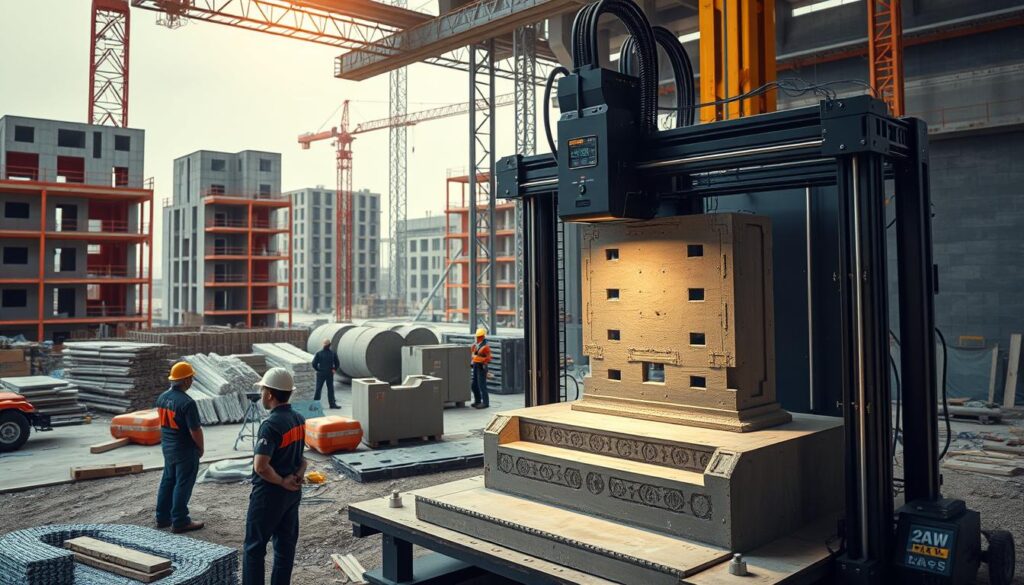
With the advent of 3D printing, the construction industry is witnessing a paradigm shift towards more sustainable and cost-effective practices. This technology is not only transforming the way buildings are constructed but also offering numerous benefits that traditional methods cannot match.
Cost-Effectiveness and Efficiency
One of the primary advantages of 3D printing in construction is its ability to reduce construction time and costs significantly. By automating the building process, 3D printing minimizes labor costs and reduces the need for expensive machinery. For instance, a report on cutting construction costs highlights how innovative technologies like 3D printing can make construction more affordable.
Efficiency is another key benefit, as 3D printing allows for the rapid creation of complex structures without the need for extensive formwork or molding. This not only speeds up the construction process but also enables the creation of intricate designs that would be difficult or impossible with traditional construction methods.
Environmental Benefits
The environmental benefits of 3D printing in construction are substantial. By using locally sourced materials and minimizing waste, 3D printing reduces the environmental footprint of construction projects. Additionally, the ability to print structures using sustainable materials further enhances the eco-friendliness of this technology.
Sustainable construction practices are becoming increasingly important as the world moves towards reducing carbon emissions and mitigating the effects of climate change. 3D printing in construction supports this goal by enabling the creation of energy-efficient buildings and reducing the amount of waste generated during construction.
Overall, the advantages of 3D printing in construction make it an attractive option for future construction projects, offering a combination of cost-effectiveness, efficiency, and environmental sustainability.
Challenges Facing 3D Printing in Construction
3D printing technology, while revolutionary, encounters significant challenges in the construction sector. Despite its potential to transform the industry, several obstacles hinder its widespread adoption.
Regulatory Hurdles
One of the major challenges is navigating the complex regulatory landscape. Building codes and standards vary significantly across different regions, and 3D printing in construction often falls into a gray area due to its novelty.
For instance, ensuring compliance with local building codes can be daunting, as these codes are typically designed with traditional construction methods in mind. To address this, there is a need for regulatory frameworks to evolve and accommodate innovative technologies like 3D printing.
| Regulatory Issue | Description | Potential Solution |
|---|---|---|
| Building Code Compliance | Difficulty in meeting existing building codes designed for traditional construction. | Update building codes to include specifications for 3D printing. |
| Zoning Regulations | Zoning laws may not permit 3D printed structures. | Revise zoning laws to accommodate 3D printing technology. |
| Certification and Inspection | Challenges in certifying and inspecting 3D printed structures. | Develop new certification and inspection protocols. |
Technical Limitations
Technical limitations also pose a significant challenge. Issues such as scalability, material durability, and printing speed are critical to the widespread adoption of 3D printing in construction.
For example, the current speed of 3D printing can be a bottleneck in large-scale construction projects. Moreover, the durability and performance of 3D printed materials over time are still being studied and improved. To learn more about the challenges and limitations of 3D construction printing, visit Tvasta Construction’s blog.
In conclusion, while 3D printing holds great promise for the construction industry, addressing these regulatory and technical challenges is crucial for its future success.
3D Printing Techniques Used in Construction

3D printing technology has revolutionized construction by introducing innovative techniques such as extrusion-based printing and powder bed fusion. These techniques are transforming the way buildings are constructed, offering enhanced efficiency, precision, and flexibility.
The use of 3D printing in construction is becoming increasingly popular due to its ability to reduce costs, improve quality, and minimize environmental impact. According to recent developments, various companies are adopting these technologies to stay ahead in the competitive construction market. For instance, 3D printing is being used in various construction projects to create complex structures with ease.
Extrusion-Based Printing
Extrusion-based printing is one of the most common 3D printing techniques used in construction. It involves the extrusion of materials, such as concrete, through a nozzle to create the desired shape. This technique is particularly useful for creating large structures quickly and efficiently.
Powder Bed Fusion
Powder bed fusion is another significant 3D printing technique used in construction. It involves the use of a laser or other energy source to fuse particles of a powdered material, layer by layer, to create the final product. This technique allows for the creation of complex geometries and detailed structures.
As the construction industry continues to evolve, the adoption of 3D printing techniques is expected to grow. With advancements in technology and the development of new materials, the potential applications of 3D printing in construction are vast. For more information on the latest technologies in construction, visit World Civil Society for insights into innovative bridge construction techniques.
Notable 3D Printing Projects Worldwide
Several pioneering 3D printing projects have been completed globally, showcasing the potential of this innovative technology in construction. These projects demonstrate the versatility and efficiency of 3D printing, from residential homes to complex infrastructure.
Icon’s Habitat2020 Initiative
Icon, a leading construction technology company, launched the Habitat2020 initiative, aiming to create sustainable and affordable housing using 3D printing technology. This project highlighted the potential of 3D printing in addressing housing shortages while reducing environmental impact.
The Habitat2020 initiative resulted in the creation of several 3D printed homes, showcasing the speed and efficiency of this technology. For more information on pioneers in 3D printing construction, visit Parametric Architecture.
Apis Cor’s 3D Printed Homes
Apis Cor, a renowned 3D printing company, has made significant strides in constructing 3D printed homes. One of their notable achievements includes printing a 400-square-foot home in just 24 hours. This project demonstrated the speed and cost-effectiveness of 3D printing in construction.
The following table summarizes some of the notable 3D printing projects worldwide:
| Project Name | Location | Features |
|---|---|---|
| Icon’s Habitat2020 | USA | Sustainable, affordable housing |
| Apis Cor’s 3D Printed Home | Russia | 400 sq. ft. home printed in 24 hours |
| Winston Churchill Memorial | UK | Complex architectural design using 3D printing |
These projects underscore the growing applications of 3D printing in construction, from residential buildings to complex architectural designs. As the technology continues to evolve, we can expect to see even more innovative projects in the future.
3D Printing Trends in Construction
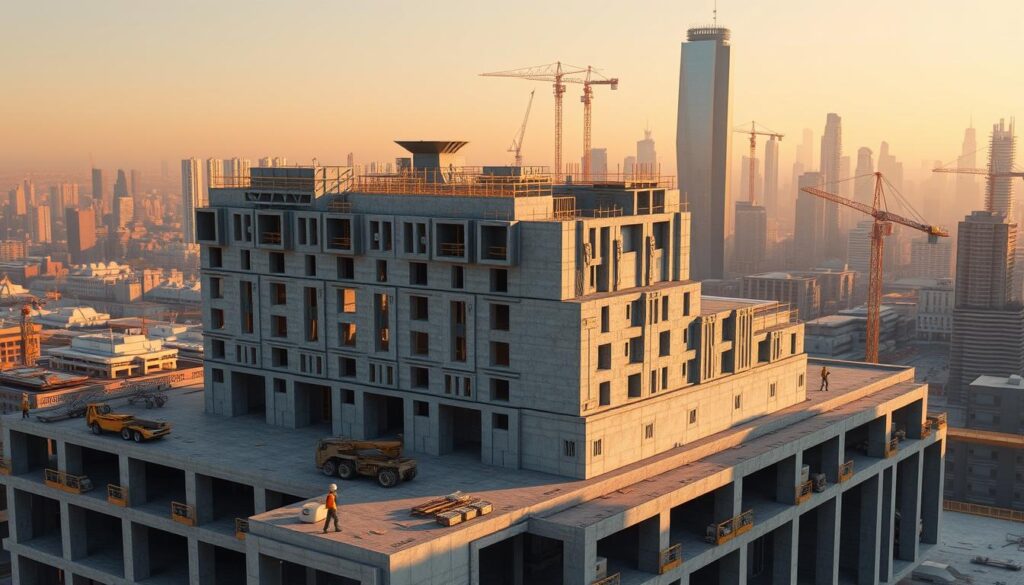
3D printing is rapidly becoming a game-changer in the construction sector, offering unprecedented opportunities for innovation. The technology has been gaining traction over the years, and its application in construction is now more pronounced than ever.
The 3D printing market in construction is expected to grow significantly in the coming years, driven by the need for more efficient, cost-effective, and sustainable building practices. This growth is anticipated to be fueled by advancements in 3D printing technology, including improved printing speeds and the development of new materials.
One of the key trends in 3D printing in construction is the adoption of sustainable construction practices. 3D printing allows for the use of locally sourced materials and minimizes waste, contributing to more environmentally friendly construction processes.
The following table highlights some of the key trends and their expected impacts on the construction industry:
| Trend | Description | Expected Impact |
|---|---|---|
| Increased Adoption of 3D Printing | More construction companies are expected to adopt 3D printing technology. | Improved efficiency and reduced construction costs. |
| Advancements in Materials | Development of new materials suitable for 3D printing in construction. | Enhanced durability and sustainability of printed structures. |
| Sustainable Construction Practices | 3D printing enables the use of locally sourced and recycled materials. | Reduced environmental impact of construction projects. |
As the construction industry continues to evolve, the role of 3D printing is expected to become more prominent. With its potential to transform traditional construction methods, 3D printing is set to play a crucial part in shaping the future of construction.
Future Prospects for 3D Printing in Construction
With ongoing innovations, 3D printing is set to revolutionize the construction sector in the coming years. The integration of advanced technologies is expected to enhance the efficiency, sustainability, and cost-effectiveness of construction projects.
Advancements in Technology
The future of 3D printing in construction is heavily reliant on technological advancements. Improvements in printer capabilities, software, and materials are crucial for expanding the scope of 3D printing applications. For instance, the development of new concrete mixes that are compatible with 3D printing technology is a significant step forward.
Innovations in robotic systems are also playing a vital role. These systems enable the construction of complex structures with higher precision and speed. Moreover, advancements in artificial intelligence and machine learning are being integrated into 3D printing processes to optimize construction workflows.
Potential Market Growth
The 3D printing market in construction is poised for substantial growth. As the technology becomes more mature and widely accepted, its adoption is expected to increase across various segments of the construction industry. This growth will be driven by the demand for sustainable and efficient construction methods.
Collaboration between technology providers, construction companies, and regulatory bodies will be essential for realizing the full potential of 3D printing in construction. Such collaborations can facilitate the development of standards and regulations that support the widespread adoption of 3D printing technologies.
The future prospects for 3D printing in construction are promising, with significant opportunities for growth and innovation. As the industry continues to evolve, it is likely to witness a transformative shift towards more sustainable and efficient construction practices.
Impact on Traditional Construction Methods
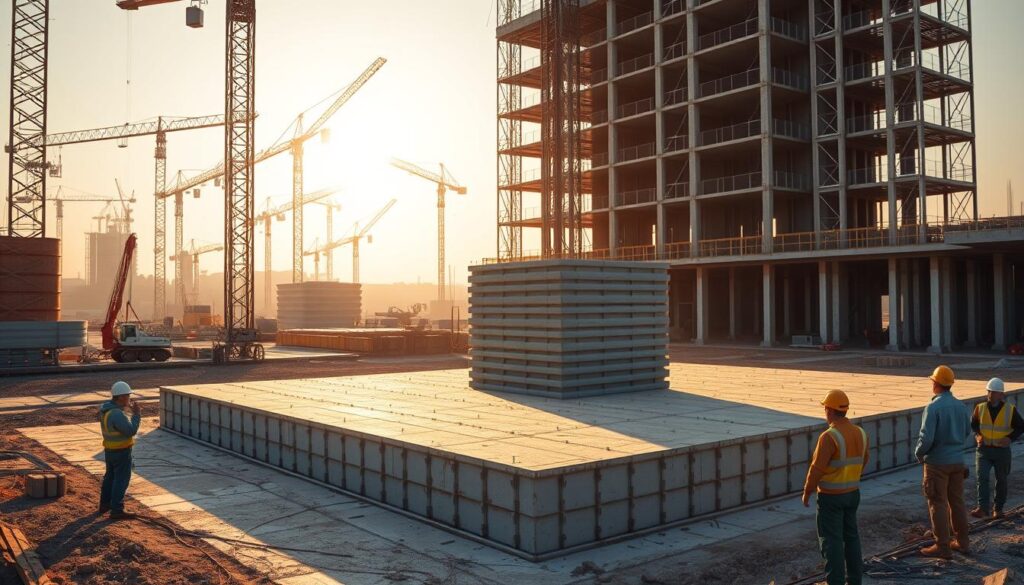
The advent of 3D printing in construction is poised to revolutionize traditional construction methods. As this technology advances, it is likely to have a significant impact on the industry, changing the way buildings are designed and constructed.
One of the primary ways 3D printing will affect traditional construction is by reducing the need for labor-intensive processes. 3D printing technology can automate the construction of walls, floors, and other structural elements, potentially decreasing the time and cost associated with these tasks.
The table below highlights some key differences between traditional construction methods and those incorporating 3D printing:
| Aspect | Traditional Construction | 3D Printing in Construction |
|---|---|---|
| Construction Time | Typically longer due to labor-intensive processes | Significantly reduced through automated printing |
| Material Waste | Often results in substantial material waste | Minimizes waste through precise material deposition |
| Labor Costs | High labor costs due to the need for skilled workers | Reduced labor costs through automation |
As the construction industry continues to adopt 3D printing technology, it’s essential to consider the potential challenges and opportunities that arise from this shift. For more insights on how 3D printing is revolutionizing the construction industry, visit Parker Brent’s blog on the topic.
The integration of 3D printing in construction not only promises to enhance efficiency and reduce costs but also opens up new possibilities for affordable housing and complex architectural designs.
The Role of 3D Printing in Affordable Housing
Affordable housing is a critical issue, and 3D printing is emerging as a key player in addressing this challenge through innovative construction methods. The technology offers a promising solution by reducing construction costs and environmental impact.
Cost-Effectiveness: One of the primary advantages of 3D printing in affordable housing is its cost-effectiveness. Traditional construction methods are often labor-intensive and generate significant material waste, increasing costs. In contrast, 3D printing uses precise amounts of material, minimizing waste and reducing labor costs through automated processes.
Sustainability: 3D printing also contributes to sustainability in construction. By using locally sourced, recycled materials, 3D printing reduces the environmental footprint of construction projects. Additionally, the ability to print complex designs that are not feasible with traditional methods allows for the creation of energy-efficient buildings.
The application of 3D printing in affordable housing involves several key benefits, including:
- Reduced construction time
- Lower labor costs
- Minimized material waste
- Increased design flexibility
As the technology continues to evolve, we can expect to see more innovative applications of 3D printing in the affordable housing sector. By embracing this technology, the construction industry can make significant strides in providing sustainable, affordable housing solutions.
3D Printing and Sustainability in Construction
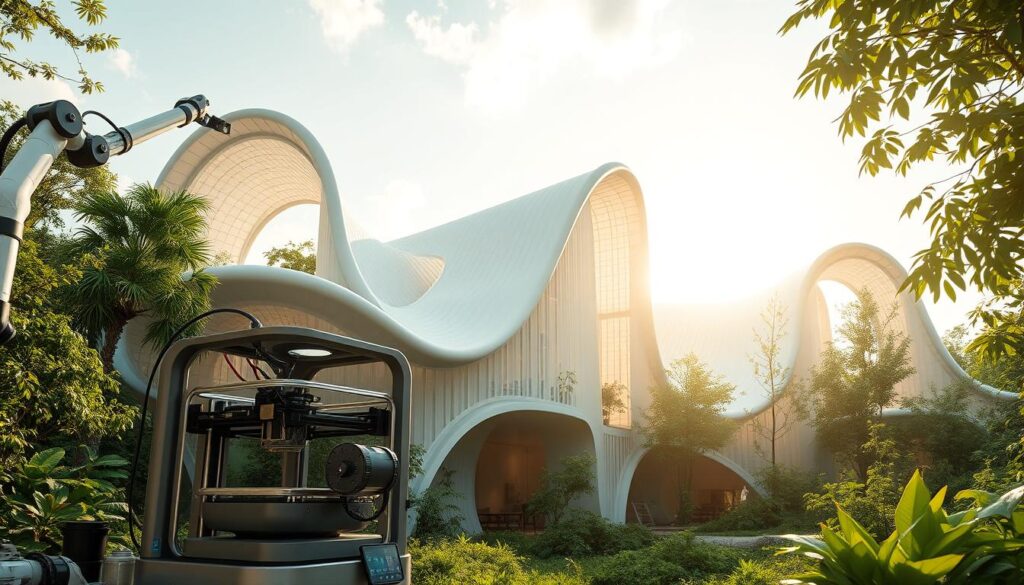
3D printing is emerging as a key player in the quest for sustainable construction practices. By leveraging this technology, the construction industry can significantly reduce its environmental footprint.
The environmental benefits of 3D printing in construction are multifaceted. One of the primary advantages is the reduction in waste and energy consumption. Traditional construction methods often result in substantial waste due to the cutting and shaping of materials. In contrast, 3D printing is an additive process that uses exact amounts of material, thereby minimizing waste.
Reducing Waste and Energy Consumption
3D printing technology for construction offers several ways to reduce waste and energy consumption:
- Precision Printing: 3D printing allows for precise construction, reducing the need for excess materials.
- Recycled Materials: Some 3D printing technologies can utilize recycled materials, further reducing waste.
- Energy Efficiency: By constructing buildings layer by layer, 3D printing can reduce the energy required for construction compared to traditional methods.
As noted by experts, “The use of 3D printing in construction not only reduces waste but also opens up new possibilities for sustainable building practices.” This sentiment is echoed by industry leaders who are increasingly adopting 3D printing technology to enhance sustainability.
“The future of construction is closely tied to the adoption of sustainable technologies like 3D printing.”
The integration of 3D printing in construction projects is a step towards more sustainable building practices. As the technology continues to evolve, we can expect to see even more innovative applications that support environmental sustainability.
Case Studies of Successful Implementation
Several case studies highlight the successful implementation of 3D printing in construction, showcasing its potential and versatility. These examples not only demonstrate the technology’s capabilities but also its practical applications in various construction projects.
Innovative Housing Solutions
One of the most significant applications of 3D printing in construction is in the development of innovative housing solutions. Companies like Icon and Apis Cor have pioneered the use of 3D printing for creating affordable and sustainable homes. For instance, Icon’s Habitat2020 initiative involved 3D printing homes in Mexico, showcasing the technology’s potential for rapid construction and cost-effectiveness.
The use of 3D printing for housing has several advantages, including reduced construction time, lower labor costs, and the ability to create complex designs that would be challenging with traditional construction methods. Apis Cor’s 3D printed homes are a testament to this, demonstrating how 3D printing can be used to create entire structures, from walls to roofs, in a matter of days.
| Project | Location | Features |
|---|---|---|
| Icon’s Habitat2020 | Mexico | Rapid construction, cost-effective, sustainable |
| Apis Cor’s 3D Printed Homes | Russia/USA | Complex designs, reduced labor costs, energy-efficient |
Infrastructure Projects
Beyond housing, 3D printing is also being successfully applied to infrastructure projects. This includes the construction of bridges, roads, and even entire building components. The technology’s ability to create complex geometries and reduce material waste makes it particularly suitable for infrastructure projects.
A notable example is the 3D printed bridge in Amsterdam, which showcases the potential of 3D printing for creating functional and aesthetically pleasing infrastructure. Such projects demonstrate the versatility of 3D printing and its potential to transform the construction industry.
The successful implementation of 3D printing in these case studies underscores its potential to revolutionize the construction industry. As the technology continues to evolve, we can expect to see even more innovative applications in the future.
Conclusion: The Future of Construction
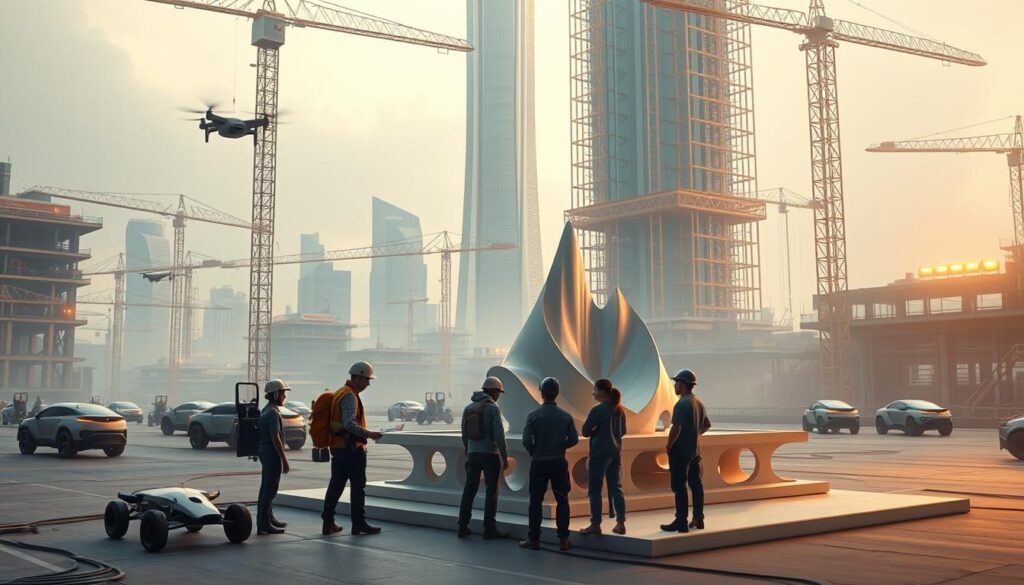
With its potential to revolutionize traditional construction methods, 3D printing is set to become a cornerstone of the industry’s future. As we have explored throughout this article, the benefits of 3D printing in construction are multifaceted, ranging from cost-effectiveness and efficiency to environmental sustainability.
The adoption of 3D printing technology is not just a trend but a significant shift in how construction projects are executed. By embracing 3D printing in construction, companies can stay ahead of the curve and capitalize on the opportunities presented by this innovative technology.
Encouraging Industry Adoption
For 3D printing to reach its full potential in the construction sector, industry-wide adoption is crucial. This involves not only investing in the necessary technology and training but also fostering a culture that is open to innovation and change.
- Investing in 3D printing technology and infrastructure
- Providing training and development programs for employees
- Encouraging collaboration between industry stakeholders
Collaboration Between Sectors
Collaboration between different sectors is vital for the advancement of 3D printing in construction. By working together, technology providers, construction companies, and regulatory bodies can address the challenges associated with 3D printing and unlock its full potential.
| Sector | Role in 3D Printing Adoption |
|---|---|
| Technology Providers | Developing and improving 3D printing technology |
| Construction Companies | Implementing 3D printing in construction projects |
| Regulatory Bodies | Establishing standards and regulations for 3D printing in construction |
As the construction industry continues to evolve, it is clear that 3D printing will play a significant role in shaping its future. By encouraging industry adoption and fostering collaboration between sectors, we can ensure that the benefits of 3D printing are fully realized.
The future of construction is being transformed by 3D printing, and it is imperative that industry stakeholders work together to embrace this technology. By doing so, we can create a more sustainable, efficient, and innovative construction industry.
Call to Action
As the construction industry continues to evolve, embracing 3D printing technology can provide a competitive edge. With its numerous benefits, including cost-effectiveness, efficiency, and environmental sustainability, 3D printing is poised to revolutionize the way we build.
Integrating 3D Printing into Your Projects
To stay ahead of the curve, consider integrating 3D printing into your construction projects. This innovative technology can help you deliver complex structures with precision and speed. By adopting 3D printing, you can reduce waste, lower energy consumption, and improve overall project efficiency.
Embracing 3D printing in construction requires a forward-thinking approach. Companies like Apis Cor and Icon are already leading the way, showcasing the potential of 3D printing in real-world applications. By following their example and leveraging 3D printing technology, you can drive innovation and growth in your construction projects.
